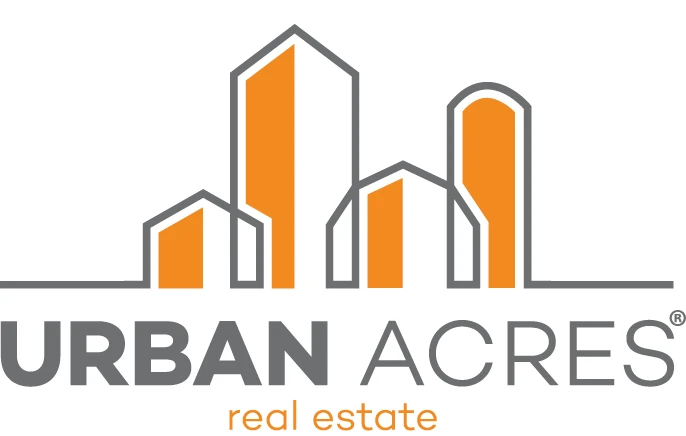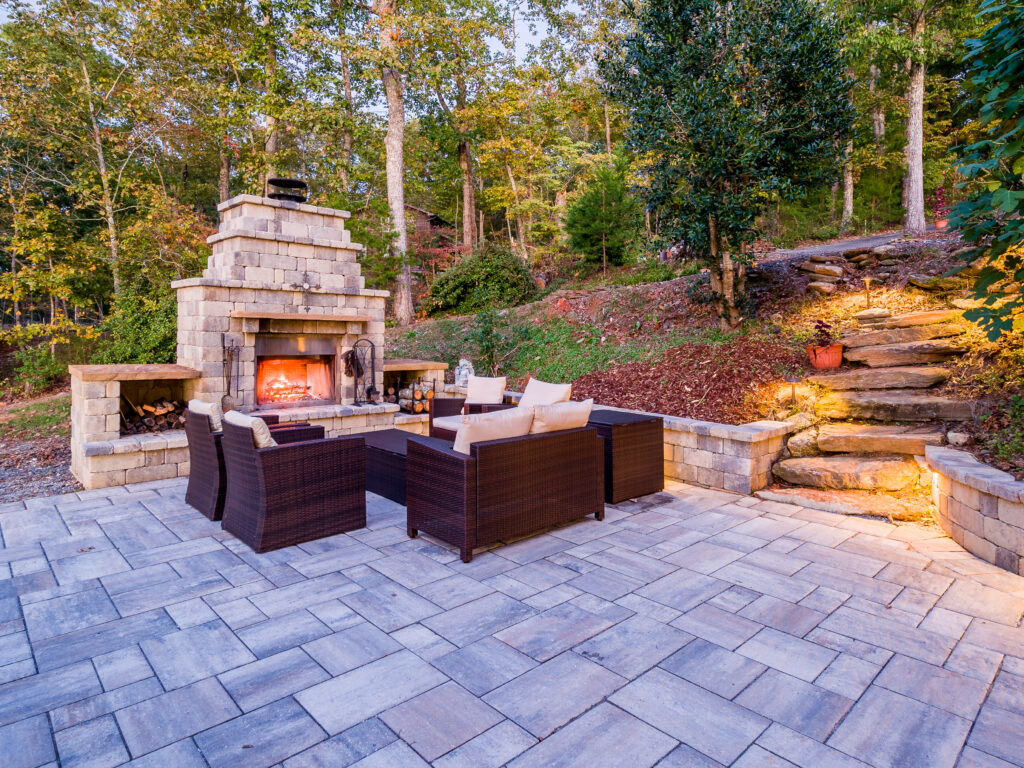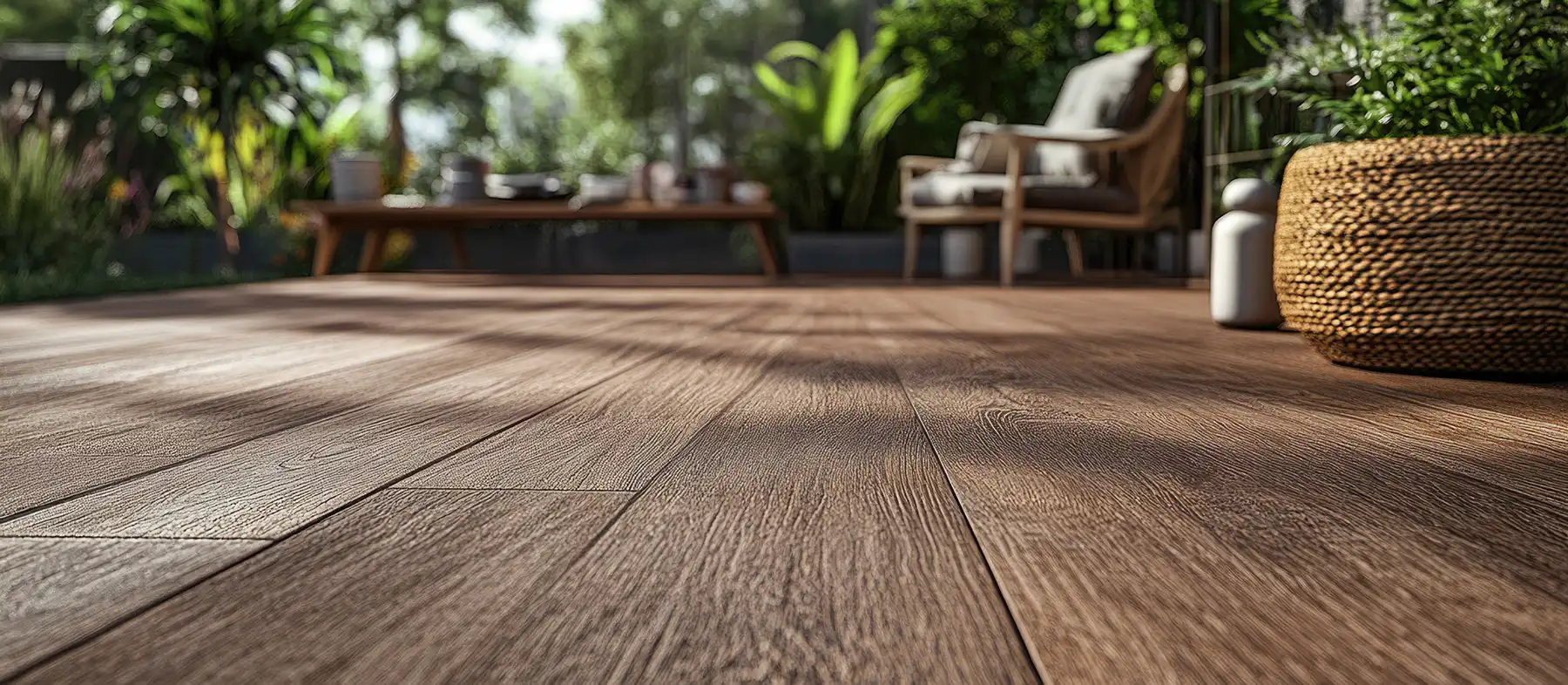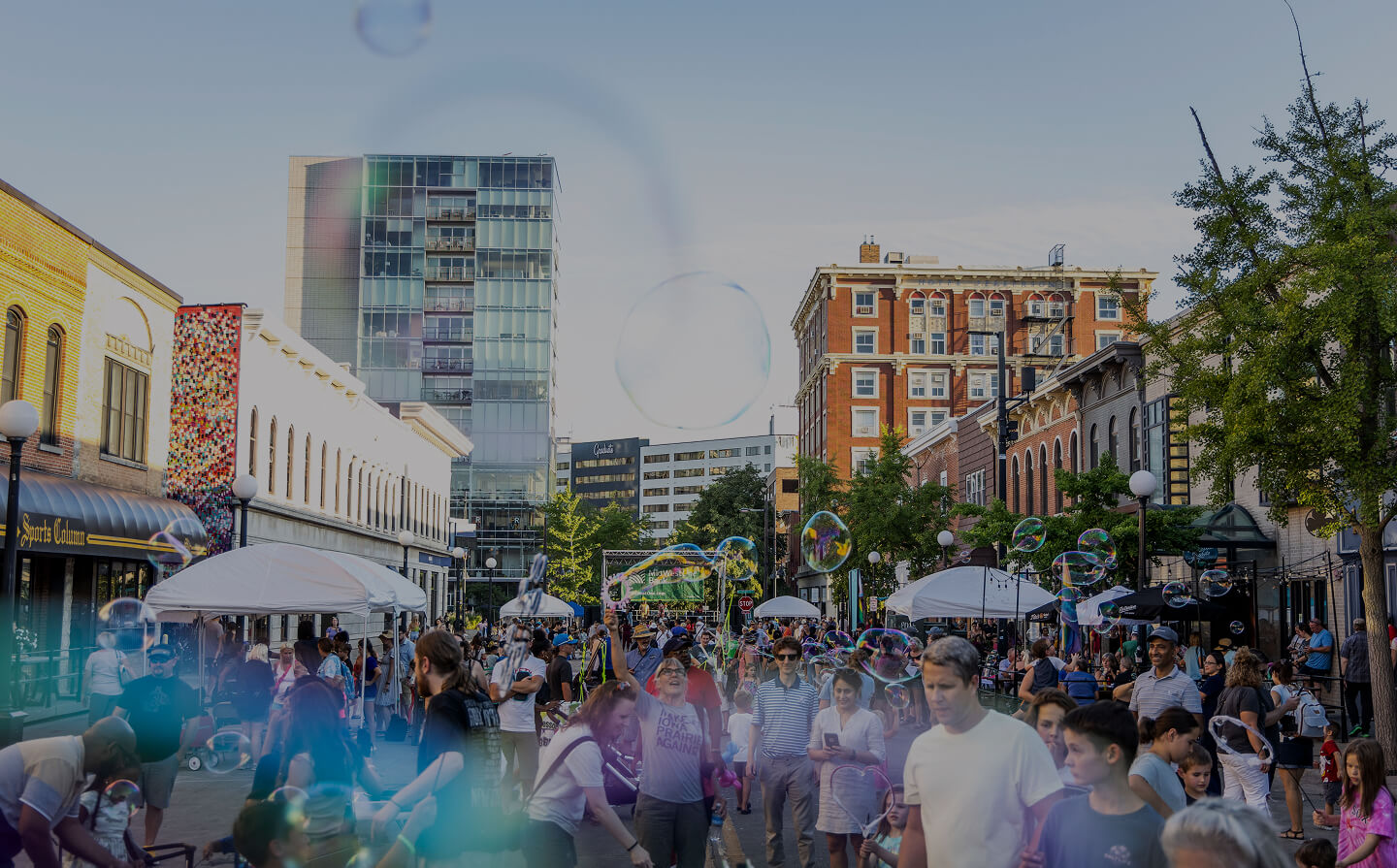A warm night spent around the firepit, chatting with friends. A Sunday afternoon spent in your 3-season porch, enjoying the breeze while you read a book. An afternoon with family, gathered around on the patio, sharing a meal.
If these scenarios sound like something you would enjoy, you’re in the right place! In Part 1 of this blog series, we focused on the indoor-outdoor living trend, sometimes referred to as backyarding, and how it’s affecting the real estate market as it grows in popularity.
Now we’re taking it a step further to show you how to create your ultimate backyard paradise! Here are some of the most popular outdoor amenities to consider adding to your space.
How to Transform Your Backyard into an Outdoor Oasis
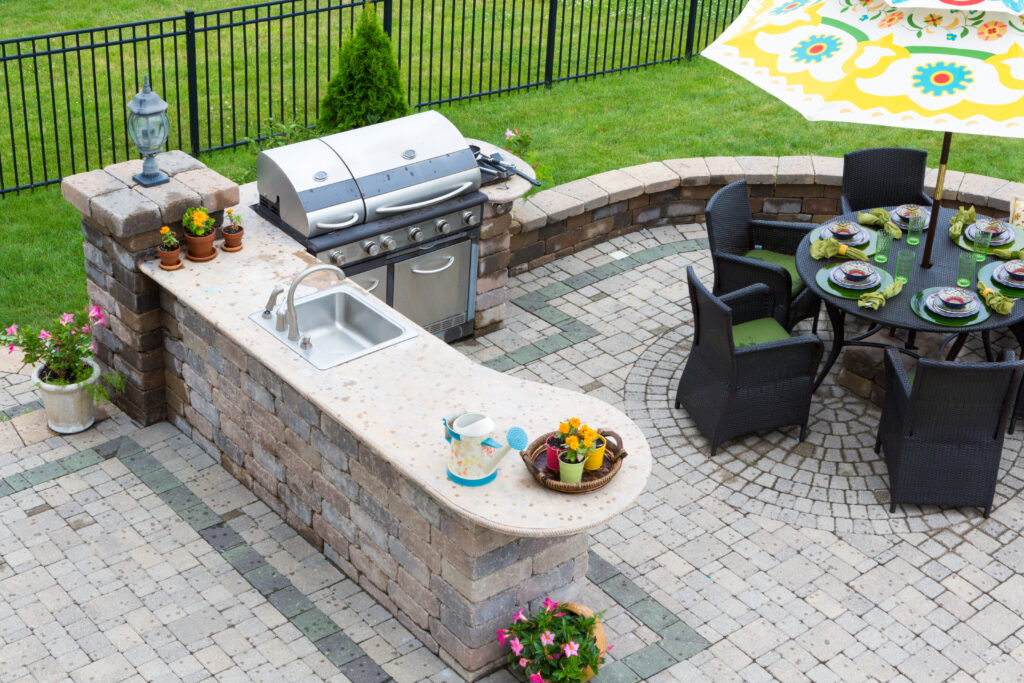
High angle view of a stylish outdoor kitchen, gas barbecue and dining table set for entertaining guests with formal place settings and flowers on a paved patio
1. Outdoor Kitchens
Backyarding is all about moving indoor activities outside. One indoor task that has become increasingly al fresco: cooking.
Outdoor kitchens are one of the most popular backyard upgrades. According to the National Association of REALTORS® (NAR), 61 percent of real estate experts chose an outdoor kitchen as the number one outdoor living addition.
These kitchens almost always center around a grill—but it’s not the average, free-standing backyard grill you’re probably thinking of. These grills are often built into a small counter or grill island, situated where an oven would be positioned in an indoor kitchen.
From there, you can add a small refrigerator, sink, or storage, making it a true stand-alone kitchen. This also helps cut back on trips to and from the indoor kitchen so you can spend more time grill-side.
If you love to grill and are ready to level up, then an outdoor kitchen might be the perfect backyard upgrade for you.
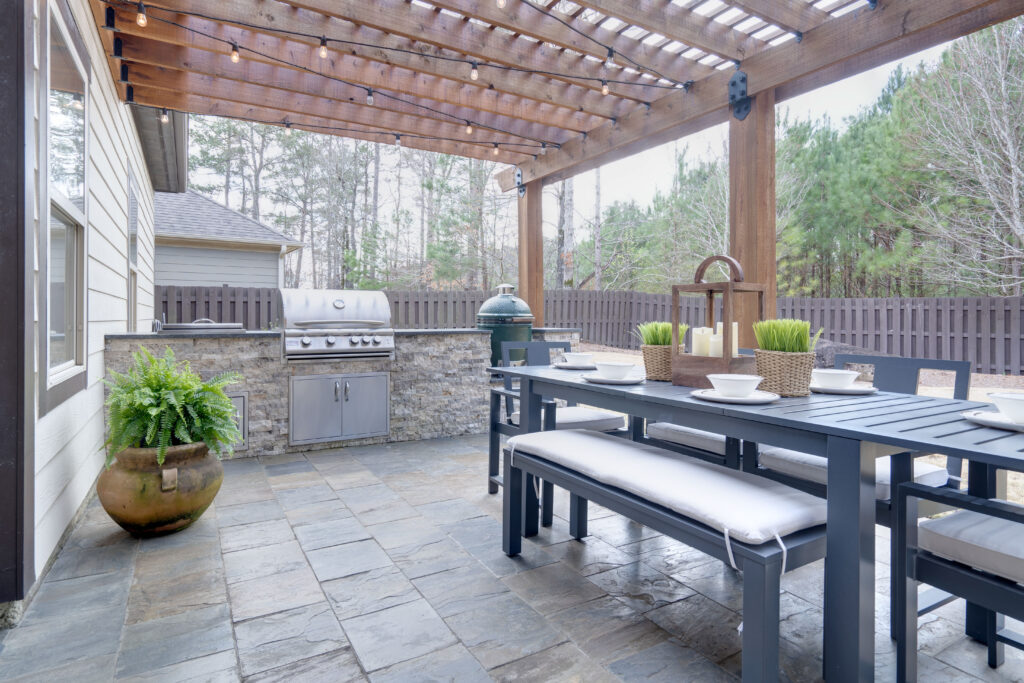
2. Outdoor Dining Room
If you’re going to cook outside, you might as well eat outside, too, right?
Many outdoor kitchens have adjacent dining areas to make the transition from cooking to eating fast and easy. These dining spaces can be a raised breakfast bar—usually attached to the outdoor kitchen—or a separate area with a patio dining set.
Of course, you don’t need an outdoor kitchen to have an outdoor dining room. You’ll still want to place your outdoor dining area as close to your indoor kitchen as possible to make food transfer a piece of cake (no pun intended). Luckily, many homes are already laid out in a way that makes this easy, with a sliding patio door just off the kitchen or dining room.
It’s also a good idea to position your outdoor eating space underneath a pergola or canopy. This allows you to eat in the fresh air for a larger portion of the year, blocking out the spring drizzle or beating summer sun. A large patio umbrella will also do the trick.
In fact, a little shade goes a long way. Forty-one percent of real estate professionals said shading was a highly sought-after outdoor feature.
3. Outdoor Living Rooms
Love outdoor R&R? You can get even more cozy by transforming your outdoor hangout space into a full-blown living room!
A comfortable patio furniture set is a must for an outdoor living room. You can then take it to the next level with accessories—think pillows, rugs, end tables, and coffee tables.
What makes this a true living room, however, is the focal point. Like your indoor family room, you can center your outdoor living room around a fireplace, TV, or both.
It’s important to note that you can’t just put any television outside. You’ll want to get an outdoor-rated TV, which is specially built to withstand rain and other weather. It also has screen modifications to reduce glare from the sun.
Don’t have the space or budget for an entire fireplace? Smaller fire features—like a firepit or fire table—can be a good alternative for your centerpiece. Plus, they’ll help keep you warm when the summer sun goes down or when the fall breeze is blowing.
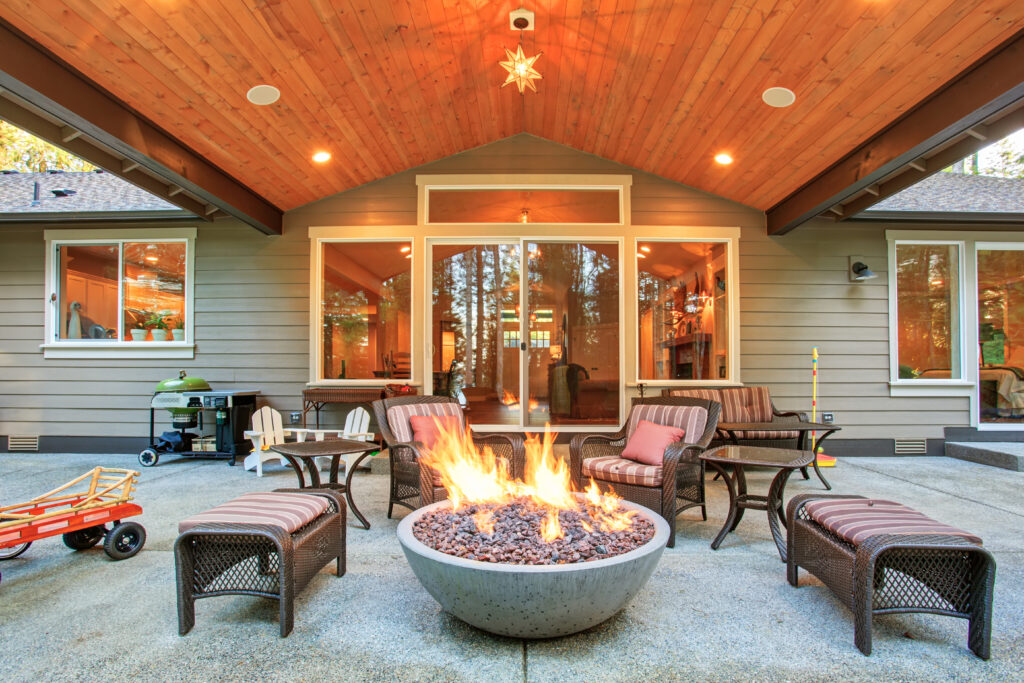
Large back yard with grass and covered patio with firepit.
4. Fire Pits
Fire pits are one of the most popular outdoor amenities, second only to outdoor kitchens. They’re also one of the easiest additions to make to your backyard.
All of the outdoor amenities we’ve talked about so far can run the gamut from basic to high-end luxury, but no other backyard feature embodies this range quite like a fire pit. You can get a wood-burning fire ring for as little as $50 at many home improvement stores, or you can spend upwards of $10,000 on a state-of-the art, ultramodern fire pit.
Fire pits are diverse in other ways, too. They are available in a range of fuel types, such as wood-burning, propane, or natural gas. They also come in a variety of shapes—rectangular, square, round—and finishes—concrete, metal, brick—to fit your backyard style. You can buy one premade or build a custom one from scratch.
From an everyday rustic look to a contemporary, sleek setup, the sky’s the limit for fire pit options.
Note: Before you build, check the fire code and burning requirements in your city or county to make sure you’re following size and location guidelines. You’ll also want to contact Iowa One Call before you dig to make sure you aren’t digging near utility lines.
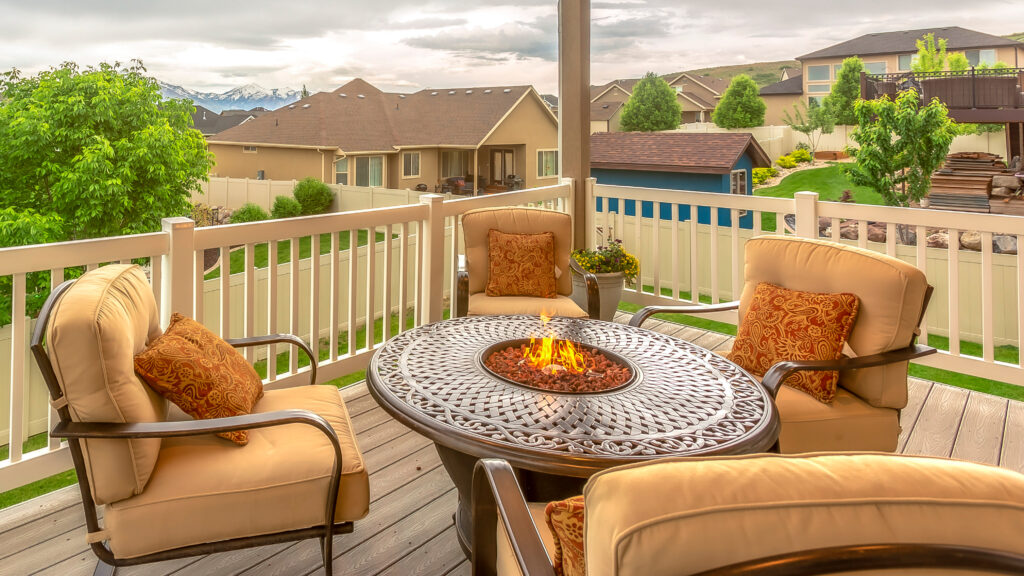
Pano frame Chairs around table with fire pit at a residential balcony framed with railings. The balcony has a beautiful view of houses in the neighborhood with lake and cloudy sky background.
5. Fire Tables
The difference between a fire pit and a fire table comes down to the width of the flat space surrounding the fire feature. On a fire table, this ledge—a.k.a. the table top—is usually six to 12 inches wide, large enough to hold snacks, drinks, and even full-sized plates. It’s the perfect combination of a cozy firepit and an outdoor dining area, ideal for people who enjoy eating while they socialize around the fire.
Fire tables come in a range of heights:
- Occasional height—low to the ground, like a fire pit (~19 inches off the ground)
- Chat height—a bit taller than an occasional height fire table, hitting just above the knee (~25 inches)
- Dining height— the typical height of a dining room table (~29 inches)
- Bar or counter height—the height of a breakfast bar, used when standing or seated on barstools; great for keeping food, drinks, and flames out of kids’ reach (~38 inches)
In other words, there’s a fire table for every style of outdoor entertaining.
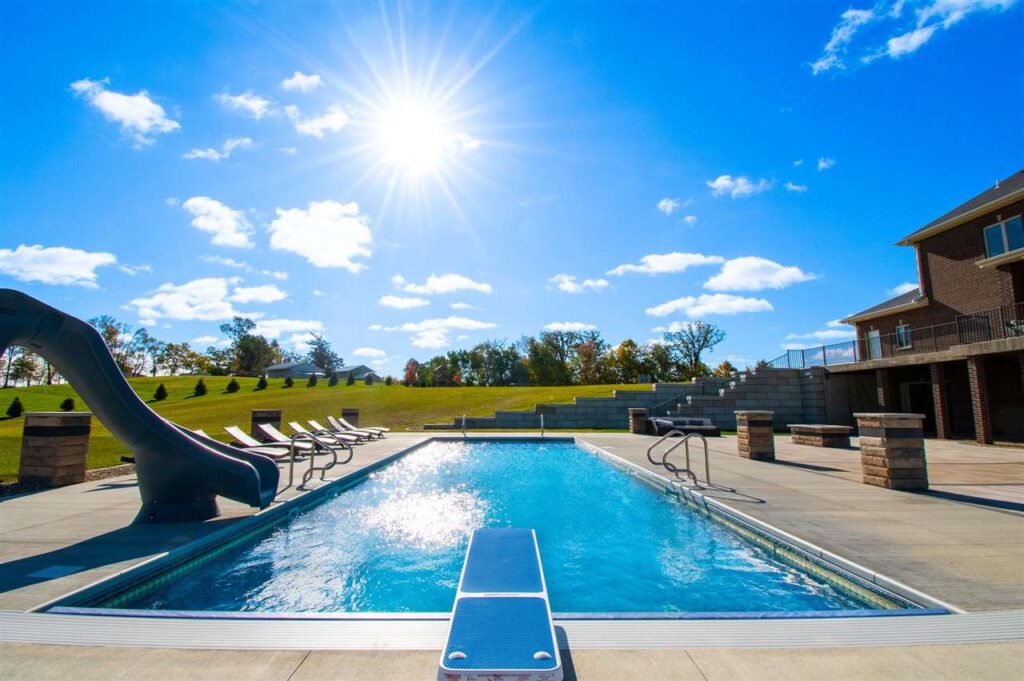
Photo Credit: 2248 Highway 1 NE in Solon, listed by Urban Acres REALTOR® Matt VandeBerg.
6. Pools
There are around 39,000 residential pools in Iowa. The majority of these are above-ground or freestanding pools, which are popular in the Midwest since they can be torn down and stowed away during the harsh winter months. They’re also more budget-friendly, ranging $500–$5,000 on average.
However, thousands of homeowners in Iowa have splurged on an in-ground pool. They’re more durable than above ground-pools, but also more costly. What you’ll pay depends on the type of in-ground pool you choose.
Vinyl: $60,000–75,000
Vinyl liner pools are formed by a base (usually concrete or sand) and the walls are made of plastic, steel, or aluminum. These are then covered by a vinyl liner to create the pool shell.
Fiberglass: $70,000–85,000
Fiberglass pools are one-piece swimming pools. This single structure is made from reinforced fiberglass, forming the pool shell, which is assembled offsite and lifted into your backyard by a crane.
Concrete: $75,000–200,000
Concrete pools are made by framing the pool with concrete rebar. A concrete mixture (typically gunite or shotcrete) is then sprayed or poured into this frame.
While they are the most customizable and durable type of residential pool, they’re also the most expensive. Costs can add up quickly, especially when customizations are involved.
Maintenance Cost
When crunching the numbers to calculate your pool budget, be sure to factor in maintenance costs. In-ground pools are one of the most expensive backyard amenities to maintain. The average maintenance cost per year for each type of pool is:
- Vinyl: $1,150
- Fiberglass: $376
- Concrete: $2,740
When choosing between an in-ground or above-ground pool for your backyard, time is also a major factor. For example, how long do you want to spend maintaining your pool? In-ground pools require more maintenance than above-ground pools.
How long will the pool take to set up? An in-ground pool takes longer to build, but has little setup time after. An above-ground pool entails assembly and tear down time each year—unless you choose to leave it up and winterize it instead.
Lastly, how much time will your family spend enjoying the pool? If you want something you can use for entertainment and exercise for decades to come, an in-ground pool may be worth the investment. If you want something you can use more casually—or if you’re not in your ‘forever home’—then a temporary above-ground pool might be more fitting.
Whichever you choose, this backyard amenity makes a big splash and provides a much-needed way to cool off during Iowa’s scorching summers.
7. Hot Tubs
Can’t decide between a hot tub and a pool for your backyard?
The main thing to consider—aside from the obvious temperature differences—is seasonality.
In Iowa, pool use is limited to the summer months. Hot tubs, on the other hand, can be used year-round. They’re a cozy winter retreat and a nice way to get some fresh air during a time of year when many Iowans try their best to stay indoors.
Like pools, hot tubs can be above-ground or in-ground. Above-ground jacuzzis range from $3,000 to 10,000, depending on which bells and whistles you opt for. In-ground hot tubs are more aesthetically pleasing and easier to access for those with disabilities, but they will run between $8,000-25,000. While that’s no small investment, it’s still much less expensive than an in-ground pool.
Another benefit of hot tubs: They don’t take up a ton of room. If you have a small patio or backyard, a hot tub is a great way to add a little luxury without sacrificing too much of your outdoor space.

Photo Credit: 2213 Highway 6 in Victor, Iowa, listed by Urban Acres REALTOR® Robin Sueppel.
8. Porches, Patios, and Decks
When you hear the phrase ‘outdoor living,’ some version of a porch, patio, or deck probably comes to mind. As common as they are in homes nowadays, these three spaces shouldn’t be overlooked as an amenity. They are, in essence, the hub of outdoor living.
Let’s quickly run through the difference between the three:
- A porch is an outdoor space attached to the front of a home, near the entryway. Porches are typically covered by the roof line.
- A screened porch is typically attached to the back of the home, like a raised deck, and includes a screen to keep bugs and other pests away.
- Often a classic feature of farmhouse style homes, a wraparound porch includes a shallow veranda that wraps around two or more sides of the home.
- A patio is an outdoor space attached to the back of the home. Patios are always found at ground level in a home. They are usually formed by a cement slab, brick, or other pavers. They can be covered or uncovered.
- A deck is a raised outdoor space attached to the home. Decks are generally built in the backyard, though not always. They are made of wood or a wood-composite material and can be covered or uncovered
Many homes have a mixture of the three. According to NAR, 48 percent of real estate experts say a porch and a patio is the most desirable combination for homebuyers. It’s the best of both worlds—the porch adds curb appeal while the patio allows for a more private gathering space.
Expert opinions aside, which one of these makes the most sense for your home? Here are a few things to consider.
Front Porch: $4,600–22,000
A front porch is the most public-facing of these three outdoor spaces. If you’re a social person who loves to chat with neighbors and get involved in the neighborhood, a porch might be the perfect outdoor space for you to feel connected to your community. It can also drastically improve curb appeal.
However, adding a porch to an existing home is not a project to take lightly. Porches are meant to be a natural extension of the home, and things can get complicated quickly depending on the size and style of the porch you’re building. If you want your porch to be covered, you’ll need to extend the roofline of your home.
Be sure to check whether your area requires a building permit for this type of addition.
Patio: ~$4,000 on average
On the other hand, a patio is one of the easiest outdoor living spaces to create. That’s because a patio is not physically connected to the home’s structure like a porch or deck. As a result, patios are less likely to require a permit, though it’s still a good idea to check.
They’re also usually less costly to build than a porch or deck, since they are made of materials like stamped concrete, stone, or brick. This makes them more durable in the long run than a wooden deck.
Another advantage of a patio: privacy. Even though decks are also located in the backyard, their higher elevation makes them a little more visible to neighbors.
Before you rush off to start sketching out dimensions for your patio, you’ll want to make sure your backyard is level. Building a patio on uneven ground isn’t just a tripping hazard; it can cause issues with your home or yard over time, especially when it comes to water drainage. For this reason, step one of building a patio is usually leveling the ground.
Deck: ~$21-25 per square foot
Prices vary widely depending on size and materials, which is why the cost of a deck is often given in price per square foot.
Unlike patios, it’s possible to build a deck on uneven ground. But the main thing a raised deck can give you that a patio can’t: a view. The quality of that view depends on the height of your deck, the landscape of your neighborhood, and your home’s surroundings, but it still offers a unique vantage point that a porch or patio cannot.
Because decks are attached to your home, many places—including the City of Iowa City— require a permit to build one.
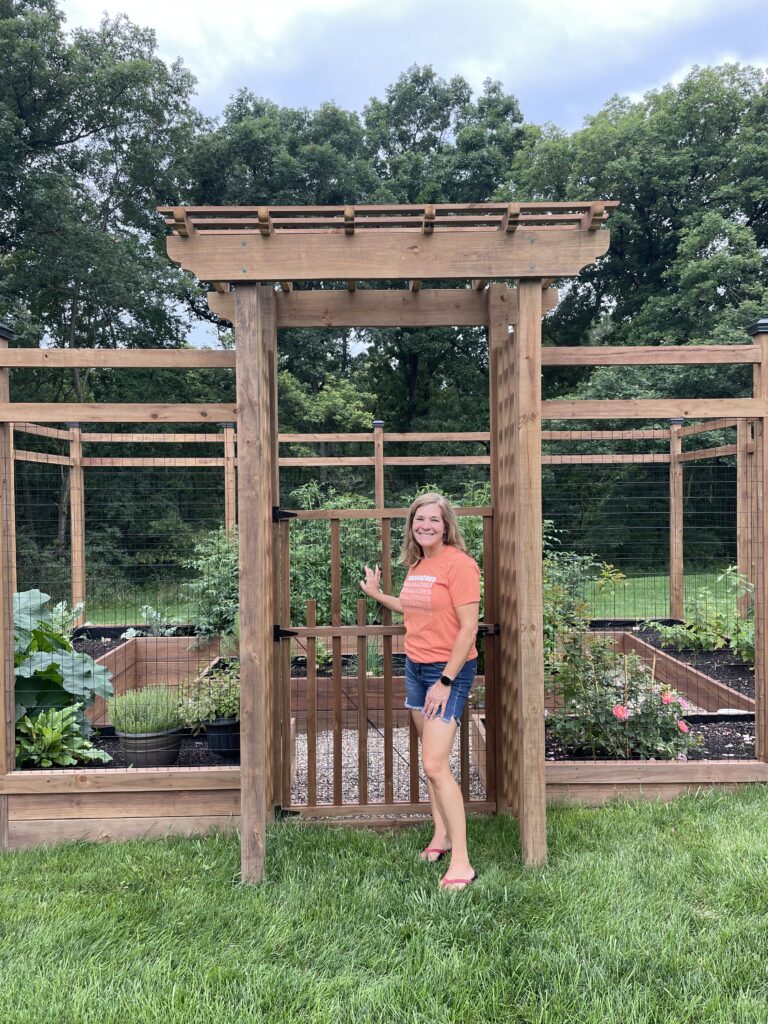
Photo Credit: Urban Acres REALTOR® Cathy Pugh enjoying the enclosed garden in her backyard.
9. Garden Oasis
If you’re more of a dig-in-the-dirt type than a sit-around-a-firepit-and-chat type, a garden might be more your speed.
Many people have backyard gardens—why not take yours to the next level? When it comes to vegetables, enclosed gardens like this one are a great way to keep deer, rabbits, and other animals from nibbling on your produce and herbs.
Through the years, gardening has evolved to include many types of gardens beyond vegetable and flower gardens. Raised beds and planters are popular options, especially for homeowners with more limited backyard space. Many people have also joined the movement to support the rapidly declining pollinator population. By planting specific types of plants, eliminating the use of pesticides, and mowing their yards less frequently, they create a more habitable environment for pollinators like bees, butterflies, bats, beetles, and other small mammals.
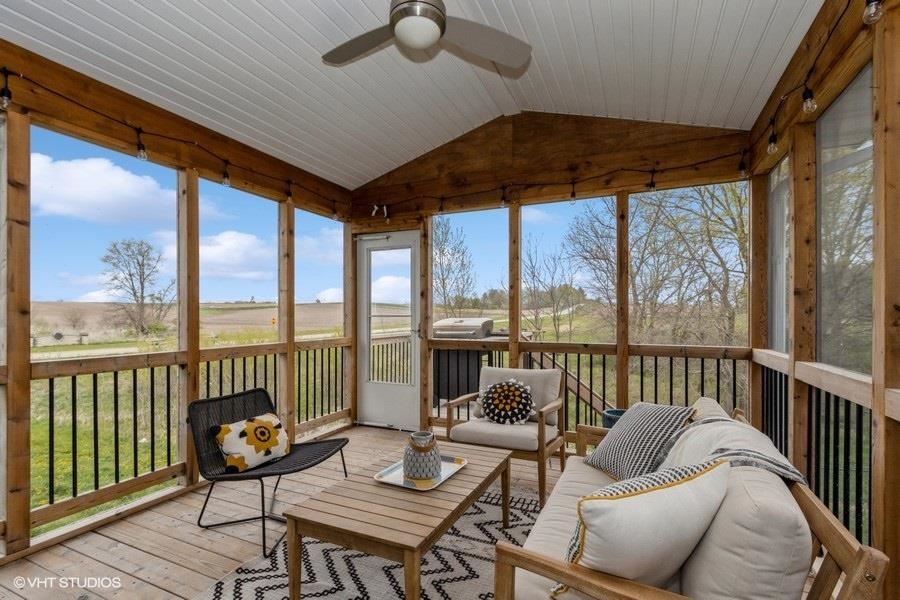
Photo Credit: 282 Chadwick Ln, Iowa City, listed by Urban Acres REALTOR® Andrea Hicks.
10. Three- and Four-Season Room
Three- and four-season rooms are almost the opposite of the backyarding movement. Instead of bringing the inside of your home out, these enclosed porches bring the outdoors in.
3-Season Room
A 3-season room is an enclosed space attached to your home, typically overlooking the backyard, that is made up of floor-to-ceiling windows. This allows you to enjoy the view, the breeze, and the sights and sounds of nature while protecting you from the direct sun and pests.
If you’re thinking that description sounds like a screened-in porch, you’d be right. The main difference between a screened porch and a 3-season room is the amount of climate control. As the name suggests, screened porches have only screens, whereas 3-season rooms have true windows. These are typically low energy-efficiency windows, giving the room some protection from the elements while still mimicking the temperature outside. There is also no insulation, making the room impractical during Iowa winters—hence the 3-season name.
4-Season Room
A 4-season room is a 3-season room with better temperature control. Four-season rooms are made with higher-quality materials—more energy-efficient windows and more insulation. Most 4-season rooms also have HVAC, so you can comfortably use the room year-round.
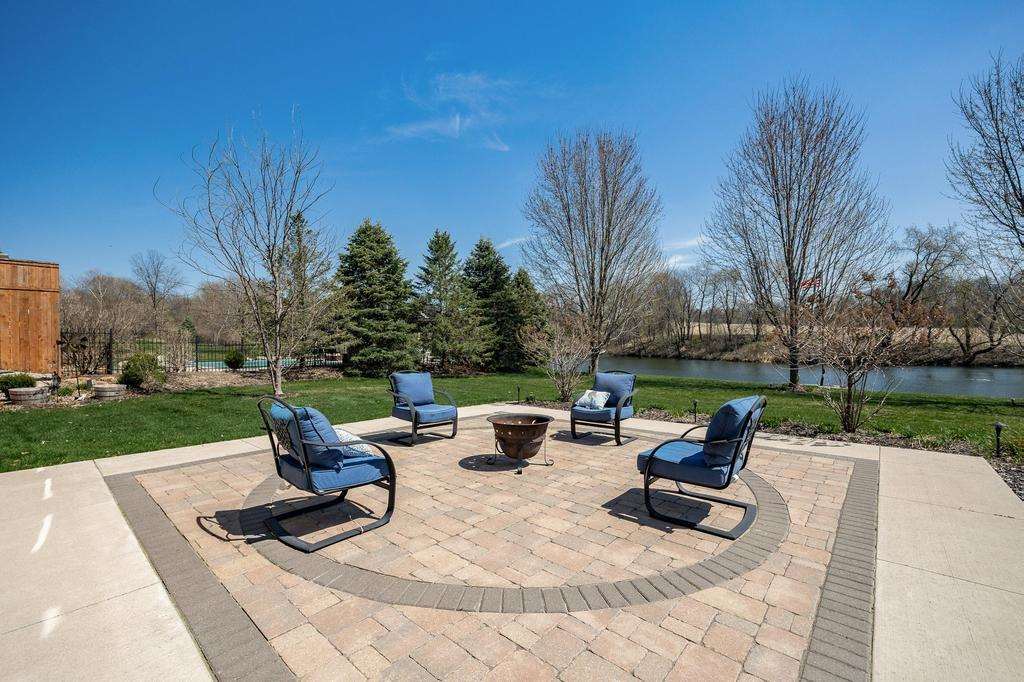
Photo Credit: 3120 Lyle Dr NE in Iowa City, listed by Urban Acres REALTOR® Jan Crosby.
Let the Backyarding Begin
Entertainment, exercise, or plain old enjoyment—whatever your backyard goals, it’s time to start creating your ultimate getaway.
As REALTORS®, your priorities are our priorities. If you’re buying, selling, or building and have any questions about outdoor amenities, you know where to find us! Reach out today.

